A Mission for the future

Alele is a cultural museum, displaying artifacts of the islands that presently are becoming very rare and valuable and need to be preserved. We have traditional tools, clothing, fishing methods, outrigger canoes, navigation, traditional housing, and various types of other items on display.
Different photographic exhibits are periodically produced and displayed in the museum. At present three different photographic exhibits are on display, which include photos of the Irooj and Lerooj (Chiefs and Chieftesses) during the German time, photos of the nuclear tests on Enewetak and Bikini atolls from 1946 to 1958, and a small display of photos from the first inauguration of the first President of the Republic of the Marshall Islands, when the nation became independent.
Alele Museum’s mission is vital and we continue to offer its services to the Marshallese community and visitors from around the world, as more and more, the younger generations are unfamiliar with the material culture of the past. On a yearly basis, hundreds of students from primary through college level visit the museum, and come with their teachers to learn about the history of their homeland. The students are usually very surprised to learn about life in the past and the great knowledge their ancestors possessed especially in regards to the very fine weaving produced by the women, and the great skills the Marshallese people developed in order to navigate and travel across vast distances of the ocean. With this awareness and understanding of the past, the students leave the museum with a stronger identity and respect for their ancestors, and this understanding helps them move forward in their own lives.
How to shop

The museum operates a small shop for the sale of local handicrafts that offers T-shirts featuring Marshallese oral history motifs, unique prints, postal first day covers, books and original videotapes which introduces Marshallese cultural heritage or current topics, and maps of the region.
Open Hours: Monday-Friday 8:00am to 4:30pm
Most articles are ready to order via the e-mail contact form.
We cannot accept credit cards at this moment.
We accept personal check, travelers checks, and Money Order in US$ made available to “Alele Museum”. We do not accept COD orders.
Shipping & Handling charge will be added to the total of your orders.
If you have an interest to purchase our items, please let us know via the e-mail contact form.
For members, you can get 10% discount on items for sale. More information about membership.
Also offered through Alele is the opportunity for local handicraft shop collaborations, through the assistance of local merchant, orders placed via email and shipped to you.
Please note: The local crafts available on this website are unique and individually hand crafted and are only to show a representation of individual sample that may or may not available at the time of your order. Please inquire by email about a specific product. This page is not for wholesale orders, if you are interested in wholesale or large quantity orders please contact the Curator.
Reading for kids

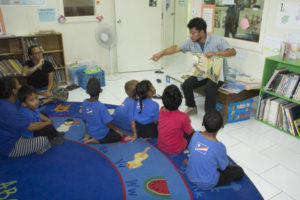 A couple of times a week, volunteers come to the library and read stories to any children who show up on that day.
A couple of times a week, volunteers come to the library and read stories to any children who show up on that day.
If you wish to volunteer to read to the children , please contact the librarian. We welcome anyone who can read English or Marshallese.
Children of all age – in general from 5 to 12 year old – attend the reading session and are a enthusiastic and captive audience.
T-shirts
First Day Covers – Philately
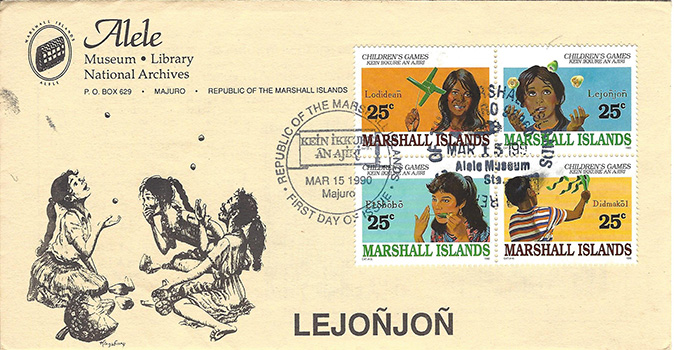
Alele Museum published a limited edition of First Day Stamped and Illustrated Envelops for collectors and philatelists.
Various illustrations and stamps series, about 70 different models, some of them accompanied with a description card. Two different sizes of envelop, large are about 241mm x 105mm , small are about 188mm x 100mm.
Illustrations on this website are for display only; the actual envelop you will receive may have small differences.
Limited quantity, price for 1 envelop Stamped with less than $4 ---- $ 4.00 Stamped with $4 or more ------ $ 4.00 + price of stamp(s)
Village Life on the Outer Islands

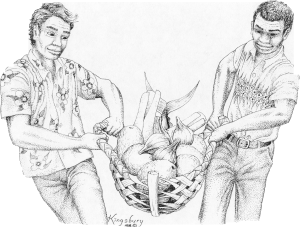
& Traditional and Cultural Aspects of Life in the Marshall Islands Nowadays.
Food is the most important aspect of Marshallese life on the outer islands. People will almost always offer food to anyone who comes to their home, for it is a way of showing respect and offering hospitality. For this reason, it is considered bad manners to refuse the food and one should at least eat a small amount. Within an atoll people are usually related, and since Marshallese have very extended families it is also common to share food and feed each other. Each Marshallese is a member of a particular jowi (clan) which is passed through the mother, and traditionally a person was supposed to offer food and shelter to anyone of the same jowi. Although the offering of food, and other goods, varies from person to person and atoll to atoll, it is still extensively followed. The main areas of exception are Ebeye and Majuro where it would be an impossibility to feed everyone. On the outer islands, where resources and means of a livelihood are much more equally distributed, this sharing of food only enhances the harmony (whether real or not) and peacefulness of the island.

On most of the outer islands today, the people still eat all types of traditional Marshallese food, although rice, flour, and sugar are highly valued, and bought from the field trip boats when money is available. Breadfruit is still an important food and can be preserved to be eaten as bwiro during the windy part of the year when breadfruit is out of season. There are numerous ways of cooking breadfruit which provides variety in the diet. The coconut tree provides drinking coconuts; coconut meat; coconut milk used in cooking; coconut sap used for drinking, as a sugar substitute for cooking, and as a leavening product in breads and bwiro; and iu (developed coconut embryo, found when the coconut has sprouted) which is eaten often on some atolls when other foods and money are scarce. Traditionally iu was an important food product, but today with copra (dried coconut meat) being made extensively on most islands, often the coconut is destroyed before it has matured and sprouted which is the stage when the iu appears. Other types of foods, eaten in varying amounts depending on their availability on a particular island or atoll, are things such as pandanus, taro, bananas, and arrowroot starch. Naturally, fish of all types, plus certain reef and coral animals such as clams and octopus are eaten extensively on all atolls.
On all Marshallese islands the land is divided into land plots called wātos, that usually extend from the lagoon to the ocean. In this way one plot of land will usually include all the various types of plants, trees, and land types. Of course, some parts of the islands are extremely narrow and it is a matter of only a few hundred feet from ocean to lagoon, but with the extended family, and land rights of each individual from both parents and extended family, usually an individual’s rights to use various land plots will provide for a fairly equal distribution of various types of resources. But since everything is done through and for the family, the individual’s rights are usually of little concern, except as they apply to the family and household unit.
Most Marshallese households consist of a sleeping house, cook house, and working or storage area. On Ebeye and Majuro this has become greatly modified because of crowded conditions, and the use of electricity and kerosene stoves. But on the outer islands most wātos, where an extended family unit lives, have all three types of structures. Often times there may be more than one sleeping house, but usually only one central cook house where everyone cooks and shares the food. Usually a household consists of ten to twenty people, with almost always a few old people and many small children and babies. Since the primary land of a person comes from the mother, most women live with their parents and when they marry, the husband moves to his wife’s land. In this way the sons would move from the land and the daughters would stay, but there are numerous exceptions to this rule. Often the most preferred by the couple and most convenient situation for everyone is followed. Since all children have rights to several wātos, usually located on several different islands and atolls, there are numerous choices a person can make when deciding to live somewhere else.
Life is very peaceful and extremely beautiful physically on the outer islands. Although it may be slow paced and calm, there is much work to be done and usually everyone is involved. The children have numerous jobs, often times trying to imitate their parents in different work that they are as yet too young to do, or merely helping with whatever they are told to do, either willingly or unwillingly. With such small islands, large households and everything needing to be done manually, it is imperative that all learn to work together and help each other. For this reason, usually there is a great deal of cooperation and responsibility taken by everyone except the youngest children.
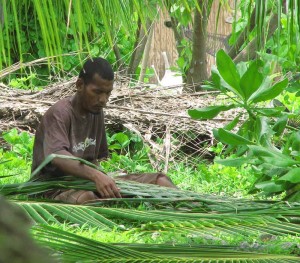
Although there is a definite division of labor with the men and women, there is much interchange in the work and most women and men know how to cook most types of food and do the other necessary daily tasks. The jobs that are almost exclusively women’s and girls’ work are scrubbing clothes (introduced by foreigners, since traditional clothing was made from mats), weaving mats, most of the cooking, and the major caring of the new born babies by their mothers. The men’s jobs are such things as fishing and gathering of the food such as breadfruit, pandanus, taro, iu (coconut embryo) for the women to cook. Also the men carve the outrigger canoes, and make the houses, although the women gather all the thatch and weave it for the houses. Since so much time today is spent in washing clothes for hours on end, this has resulted in less free time for the women, so usually to an outsider it appears as though the women do more work than the men. Depending on the season, and the availability of outside food, the amount of work a man does can vary greatly. If much rice and flour are available, the men do little gathering of food, but if there is none, then every day they must fish and gather iu (coconut embryo), or other foods, which can mean having to sail to other islands in the atoll. If the men are making copra, and the island has a lot of it, then this can consume a great deal of time and effort. If the atoll is poor and has old and poor coconut trees, there may be little copra available and thus less work on the one hand, but more work in obtaining natural foods, since copra provides the main source of money to the people on the outer islands. Often times the men and women will kowainini (make copra) together, with the men cutting down the undergrowth; the women gathering the coconuts into large piles; the men husking the coconuts and bringing them to the house; the women breaking open the coconut shells; and everyone participating in smoking the copra or drying it in the sun. The last step of cutting the copra out of the shells is almost always done by the men with everyone helping to fill the bags.
Some of the atolls today have co-op stores that buy the waini (copra) from the people, and with this money they in turn can buy from the store. The co-ops are resupplied by orders sent into Majuro on the short wave radios (which very often break down), and then the supplies are sent out to the islands on the field trip boats.
Today some of the villages have a telephone and internet connection that can be used to communicate with Majuro or other atolls. It is provided for the entire population so one person oversees the use of the telephone and internet, and it is used only for emergencies, various types of networks such as the Education net, or Health net and for basic communication needs. There is a satellite dish on the islands/atolls where there is internet and phone connections. A few people in any given village may have their own short wave radio which means they can connect directly to someone else who has a short wave radio on another island or in Majuro or Ebeye. The short wave radios are run by solar power and each household has usually one electric light also run my solar power.
If no co-op exists, or if the co-op order is not resupplied when a boat comes, a person’s waini is sold to the store company represented on the boat, and with this money the individual buys his goods directly from the boat. Since logistics are such a vast problem with such large ocean areas and only two or three government boats that can provide services, it is no wonder that communications and resupplying or supplying directly from a boat, can result in numerous problems, delays, and frustrations. Some islands have private stores where individuals buy large amounts from the boats directly. Often times this can result in a monopoly since the individual has money available and sometimes buys out almost all available supplies from the boat, which forces the people to buy from him, rather than the boat. Such people as the teachers, and health aides on each island where schools and dispensaries exist, receive government salaries. Their salaries supplement the available money on the outer islands since most people will help their relatives and friends obtaining food and other necessary items. These outside pay checks have also resulted in a less equal distribution of goods for some people, whereas with the extended family and the relationships of people, everyone has numerous mothers, fathers, sisters, brothers, cousins, and grandparents.
The relationship of a person to his/her extended family is quite complex. The following is a simple explanation of the basic relationships that exist for everyone. All parallel cousins (children of mother’s sisters or father’s brothers) are considered sisters and brothers; cross cousins (children of mother’s brothers and father’s sisters) are considered as available spouses. Genealogies are usually fairly well known because of the lineage systems and as a result the relationships of people are carried down for many generations. All brothers and sisters (either direct or indirect) of the real grandparents of a grandchild are also grandparents to that child. Also, all the real mother’s sisters (direct and indirect) and father’s sisters are mothers to the real mother’s child. All brothers (direct and indirect) of the real father, are also fathers to his child. The mother’s brothers (direct or indirect) are rūkoream (Rālik) or wūllepam (Ratak), something like uncle, but in a possibly more respected position, for he may become the alap (head) of his mother’s lineage and thus her land, which is also the child’s lineage and land. As is evident in this brief explanation, it is almost impossible for a Marshallese to be alone, and through his or her extended family and land rights, he or she has much security and love.

Although to outsiders it may seem as though babies and small children are smothered in affection and love, they are also disciplined, if loosely, and as soon as a younger child is born or adopted, which usually is within one and one half to three years, the older child is no longer favored and must learn to give and share in all aspects with the new child. Each child learns to give to the youngest not only food and articles but also love and affection. It is not unusual to see small children fondling and playing with and being very absorbed in the life of a new born baby. Almost all boys, as well as girls learn to care for babies, and when playing, the older children, even if very young themselves, automatically watch after the younger children or babies.
Three types of people have rights on a particular plot of land. These are the irooj or lerooj (chief or chieftess), alap (lineage head), and ri jerbal (worker). The irooj is considered the owner of the land with permission from him either granted for use of a particular wāto (land plot) or understood from one’s family’s traditional use of a particular wāto. He or she is the only person of royal blood. The alap is the head of a particular lineage and often is the highest person in control of a particular wāto, who may be available to make decisions regarding his land when there are problems, for on many atolls no irooj is present. The alap makes decisions, often delegates who can work the land, especially in regards to making copra, and is the go-between for the ri jerbal and the irooj. The alaps usually make up the Councils found on the outer islands who meet to make local decisions in one particular village. Also the alaps decide how to divide the food at parties and keemems (first birthdays of babies), and how much food should be prepared when an irooj visits. Anyone may become an alap depending on his or her lineage. Both with iroojs and alaps, if a person is considered to be incapable mentally of carrying out his responsibilities then the position is delegated to the next person in line. Alaps are kajoors or commoners. The ri jerbals are the people who are designated as the workers on a particular wāto. A person may be an alap on one wāto, and only a ri jerbal on another, depending on inheritance and family land rights. From the ri jerbal is determined who has land rights and where, for usually if the woman or man is the ri jerbal on a particular wāto, his or her family can also use and work the same plot of land. In this way land distribution is very diverse and leaves several possibilities as to how and when it may be used as a place to live, a place to gather food, or to make copra.
All land in the Marshall Islands is owned and basically controlled by the iroojs and leroojs (chiefs and chieftesses). Traditionally there were great warring parties which included the iroojs and his subjects of a certain area or atoll who would sail to other atolls in an effort to conquer and control new land and people. These war parties were common and resulted in frequent changes of power and land by different iroojs. The interchanging of the land and some of the power and influence through the wars of the iroojs was halted during the late 1800s by the various missionaries and other foreigners. As a result, the distribution of the land and power to the various iroojs and leroojs of today is based on the irooj families who were in power at the time the warring ended. Some iroojs and leroojs control areas in the Marshall Islands which may include several atolls, while others may control only parts of an island or atoll such as on Milli Atoll where there are numerous iroojs. Today, although the iroojs still exercise extensive control and influence over the people, the traditional power structure has changed greatly, since the National Government is run by the Nitijela or the national legislative body of elected officials from throughout the country. The irooj system is hereditary and passed through the mother (although today it is often passed through the father). Traditionally there were several divisions of iroojs. The highest division was and is an irooj or lerooj born of parents who were or are both iroojs. The other divisions ranged below this to the lowest division of iroojs being a person who has some irooj blood from one parent with the other parent being a commoner. This has also been modified somewhat because of a larger population, more marriages of iroojs and leroojs with commoners, and because of lineages dying out with uncertainty as to the next lineage in line.
One of the main changes that has occurred because of the introduction of foreign cultures is the introduction of money into the irooj system. Traditionally the best foods and goods were given to the irooj and his family, and although this is still practiced on the outer islands, in Majuro and Ebeye money also plays a part in showing one’s respect to his or her irooj. Also a certain percentage of the money from copra goes to the irooj and alap (lineage head) for use of the land. As mentioned before in another context, this has created a much less equal distribution between the irooj class and the commoners.
The Marshallese people have lived closely together physically, socially, and mentally for a very long time and they have learned to overcome disputes, differences, and foreign influence, and have always lived with a fair amount of harmony and cooperation on very small pieces of land surrounded by great expanses of ocean. Today it seems as though some of this is eroding due to the competition introduced by different religions, the desire for money by many people today, vast cultural upheaval, and the increase in foreign contact and influence. Nevertheless, the Marshall Islander moves through all these changes and upheavals with a great sense of calm and mutual concern and support for each other.
Present Days

Today the main urban area and the Capitol of the country is located on Majuro Atoll with a population of about 35,000 people throughout the atoll. With urbanization came all types of businesses, jobs, construction, goods to buy, etc., so orientation to life in the two urban areas (Ebeye on Kwajalein Atoll being the only other urban area) is very different from what is found in the outer island villages. As a result of these changes, the life style has changed greatly and much of the old ways are dying out. For example, very little indigenous produce is available in Majuro and as a result, very little Marshallese food is preserved or eaten. This necessitates a dependence on imported goods, often with little or no understanding of a particular good’s value. The main diet in Majuro consists of rice, bread, canned meats, frozen chicken, sugar, tea and cola although now some produce is now available brought in from the U.S.
Life in Majuro is oriented around money and the realization of the necessity of having jobs in order to survive. As a result of several thousand people living in Majuro, the traditional land rights and divisions, and uses of the land and its resources, have been drastically altered. There is little room for the breadfruit and coconut trees, let alone open spaces with no people or houses, and pollution is extensive near the shores of the lagoon. Even with all these changes, people are still very friendly, kind and generous. Within the household unit, although the life style may not look traditional with so many obviously introduced products, many aspects of life, including relationships, teachings, and family structures, are still basically strong and traditional in their orientation.
Some of the most familiar names in the Marshalls to the Western world are such places as Kwajalein, where extensive fighting occurred during WWII and where today is located a U.S. Missile Range; and Bikini and Enewetak where 67 hydrogen and nuclear bombs were tested from 1946 until the late 1950s.
Kwajalein Atoll is the largest atoll in the world. On the island of Kwajalein within this atoll, is a U.S. Missile Range. As a result of the missile range another urbanized area, Ebeye, located five miles from Kwajalein island, has developed in the Marshalls. On Ebeye live about 12 to 14,000 Marshallese who depend for their livelihood on the salaries generated from employment on the missile range. Although Ebeye is much less cosmopolitan than Majuro, the traditional Marshallese life style has been altered by the dependency on money and jobs, and the lack of natural resources. Ebeye is extremely small (approximately 90 acres), crowded, and drab with its lack of trees, open spaces, and superimposed dependency on the missile range.
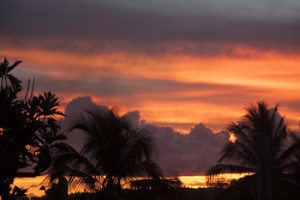 Basically all other atolls and islands in the Marshalls are what is referred to as the “outer islands”. Life on these islands is still orientated to the land and ocean with only occasional outside contact by field trip boats every one to three months.
Basically all other atolls and islands in the Marshalls are what is referred to as the “outer islands”. Life on these islands is still orientated to the land and ocean with only occasional outside contact by field trip boats every one to three months.
The island of Jabor, in Jaluit Atoll, is slowly becoming a sub-urban center along with Wotje Island in Wotje Atoll since both have public high schools, a few small stores, usually at least monthly field trip ships, and an increasing population. Jabor was the government center during both the German and Japanese periods in the Marshalls.
From Trust Territory to Independent Country

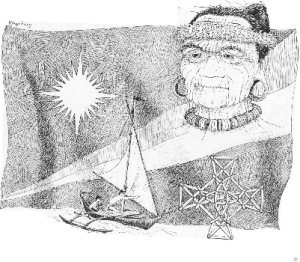
In 1947 Micronesia was established as a strategic Trust under the U.N. Security Council, the only Trusteeship set up in this manner after WWII. It became known as the Trust Territory of the Pacific Islands and was administered by the U.S. under the auspices of the United Nations. On July 1, 1951, the administration of the Trust Territory of the Pacific Islands was transferred from the Navy to the Department of the Interior, and was administered by this department until 1986.
The political situation in the Marshall Islands and the Trust Territory of the Pacific islands (TTIP) during the 1960’s to the mid 1980’s was a very confusing and uncertain time as to the political outcome of the area. When Micronesia was established as the TTIP in 1947, it was designated as a “strategic trust” and was the only area of the world ever designated as such! The strategic trust meant that special consideration by the Security Council of the United Nations would be necessary in order to change the political status of the TTIP. Since the Security Council’s five permanent members have veto power, the complexity of changing the status in the TTIP was very different than the majority vote by the General Assembly which was necessary to change the status, or grant independence to the other Trusteeships set up after WWII.
In 1965 a Congress of Micronesia was established which was the first TTIP representative government organization. TTIP at this time was divided into six administrative districts which were the Marianas, Yap, Palau, Chuuk, Pohnpei, and the Marshalls. The congress was a bicameral elected legislature that originally only had an advisory function to the executive offices of the High Commissioner, who was appointed by the U.S. Secretary of the Interior, and had veto power over the Congress of Micronesia’s decisions.
Since the Trusteeship Agreement was to expire in 1981, various types of negotiations and votes occurred throughout the TTIP, and in individual districts during the late 1970’s. The Marianas voted in 1975 to accept Commonwealth status with the U.S., much like the political status of Puerto Rico. Kosrae (formerly Kusaie) was established as a separate district in 1977, so the number of six districts was maintained.
In July 1978 a referendum was held by all the districts except the Marianas to accept or reject the Constitution of the Federated States of Micronesia. The constitution was written in Saipan from July to October 1975 by constitutional convention delegates from all districts which included traditional leaders. Each district in the TTIP had differences of culture, language, history, circumstances, wealth, and historically were never united as one. As a result, the idea of a united Micronesia was quickly dissolving. The vote in July 1978 was accepted by the districts of Yap, Chuuk, Pohnpei, and Kosrae, but rejected by Palau and the Marshalls Islands.
One of the more heated disputes within the Marshall Islands concerned the money generated by the Kwajalein Missile Range. Most Marshallese felt that this money and the taxes paid by the U.S. people living there should be shared with the Marshall Islands.
During the later years of the 1970’s and early 1980’s the political atmosphere in Majuro (District Center of the Marshalls) was very heated and controversial. But the understanding and significance of all this to the people on the outer islands was somewhat minimal. Eventually with extensive negotiations with the United States the Compact of Free Association was established and the RMI became an independent country after the Trust Territory was dissolved by the U.N. Security Council in 1986.

The Republic of the Marshall Islands is fully sovereign in domestic and foreign affairs, but gives responsibility for defense to the United States. RMI became a member of the United Nations in 1991.











You must be logged in to post a comment.